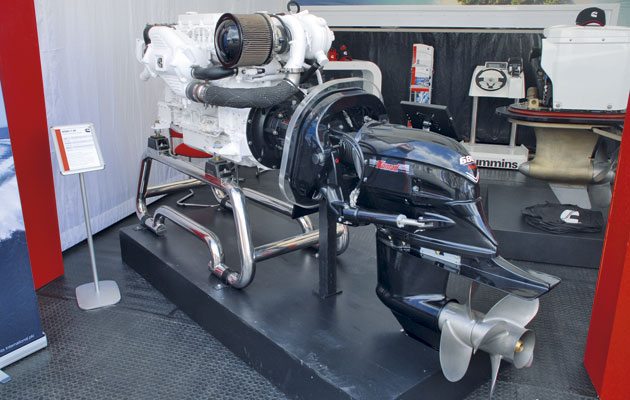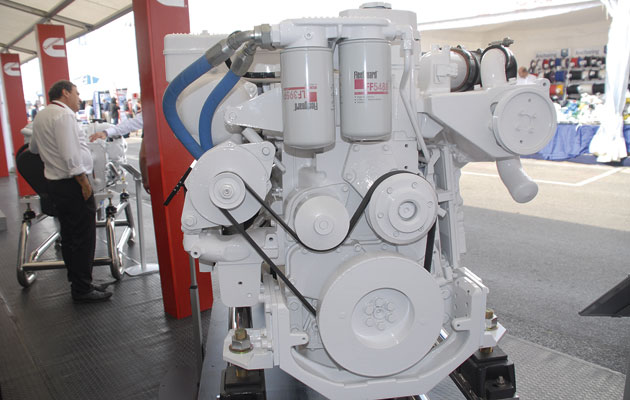Cummins’ new engine promises to power up sterndrives by pairing up with Konrad Marine’s super-tough leg. We take an in-depth look at this new set-up
Until recently most mainstream diesel sterndrive packages have been limited to a maximum power output of 400hp.
The huge torque figures generated by more powerful diesel engines have simply been too much for the gearboxes of production sterndrives to cope with.
For a while Cummins offered the 480hp QSB5.9 with Mercury’s NTX sterndrive but the engine’s 942ft/lb of torque was right on the limit of what this sterndrive could handle.
Cummins has now had a rethink and decided to raise the stakes even higher with a yet more powerful engine/sterndrive combination.
The key to this punchy new offering is Konrad Marine’s super-tough sterndrive leg. So confident is Cummins of its ability to cope with high torque loadings that it will partner it with the company’s latest QSB6.7 engine.

Technically this new 6.7-litre engine produces the same 480hp maximum power as the 5.9-litre block, but by lengthening the stroke and increasing the bore, it has wrung even more torque out of it.
It now produces a formidable 1,165ft/lb (1,580Nm) at just 2,000rpm, far in excess of Volvo’s 400hp D6, which maxes out at 722ft/lb.
There are a number of reasons why the new QSB6.7 is so torque rich.
With a stroke-to-bore ratio of 1.16 (meaning the stroke is 116% longer than the cylinder bore’s diameter), this is a long stroke engine that exerts more torque on the crankshaft than a faster revving short stroke design.
A new 24-valve cylinder head also allows the 6.7-litre block to breathe more freely.
A fixed geometry after-cooled turbocharger force feeds air into the combustion chamber, without the need for an additional mechanical supercharger to boost its bottom end grunt.
The common rail injection system runs at 23,000psi (1,600 bar). It also has a specially designed twin-cone air filter system, which in conjunction with the high injection pressure, results in very low noise levels.
Fuel for thought
Cummins claims the QSB6.7 is very fuel-efficient and it has already cleared the forthcoming EPA Tier 3 emissions controls.
Due to demand from the US Military it is also engineered to run on different fuels, including diesel, kerosene and jet fuel.
This may not be of much use to leisure boat owners but it does mean the engine has been fitted with extra-durable injectors and a beefed up fuel pump that can run without the inherent lubrication of conventional diesel fuel.
You can also thank the US Military for insisting that the engine has a dry-run capability that enables it to idle for 30 minutes out of the water without damage.
It does this by circulating the water that it holds in the raw water system. When an engine is run at idle it produces very little engine heat anyway, and as soon as the boat is launched it then draws in external sea water.
For easy servicing in the confines of an engineroom the oil filters are front-mounted. Oil changes can be extended to 500 hours if ultra low sulphur diesel is used.
Through the use of composite components the bare engine (bobtail) weight has been kept down to 634kg, just 22kg more than the QSB5.9 and a modest 50kg heavier than the 5.5-litre Volvo D6.

Matching such a powerful engine to the Konrad 600 sterndrive is a bold move.
Sceptics may shake their heads at any sterndrive’s ability to cope with all that torque being transmitted through two right-angle bevel gears and a compact gearbox set in a slender sterndrive leg, but Cummins assures us that the package has been submitted to 500 hours of sea trials.
Thick skin
The twin prop Konrad 680 sterndrive is the toughest of the 600 series. Its external casings are claimed to be twice as thick as its closest competitor’s (preusmably the Volvo DPH drive) and its precision-cut 6in bevel gears are significantly bigger than the industry norm of 4in.
As well as a size advantage, the gears themselves are precision cut and ‘harmonically tuned’ to be perfectly balanced, resulting in reduced stress and vibrations.
Sensibly, it has opted for an inline inboard gearbox behind the engine block, rather than squeezing one into the sterndrive leg.
Engineering logic aside, not having a gearbox in the sterndrive makes for a stronger sterndrive transmission. To help keep all this torque transfer in check an oil-cooling system circulates around the sterndrive leg.
This enables the upper section of the sterndrive leg to benefit from the cooler submerged section. However, as there is no facility for the exhaust to exit through the sterndrive leg this helps toughen the construction.
Cummins applications
The QSB6.7 is not just aimed at sterndrives as all variations can be supplied with conventional shaftdrive gearboxes.
The most powerful version, the 550hp QSB6.7 producing 1,250ft/lb of torque was initially built purely for shaftdrive installations.
Princess Yachts now offers this engine as an upgrade over the 435hp Volvo D6 on the Princess 43. However, it seems that Cummins is going to push the sterndrive boundary higher.
Once Konrad Marine has approved, it appears the 550hp QSB6.7 will be offered with the Konrad 680.










